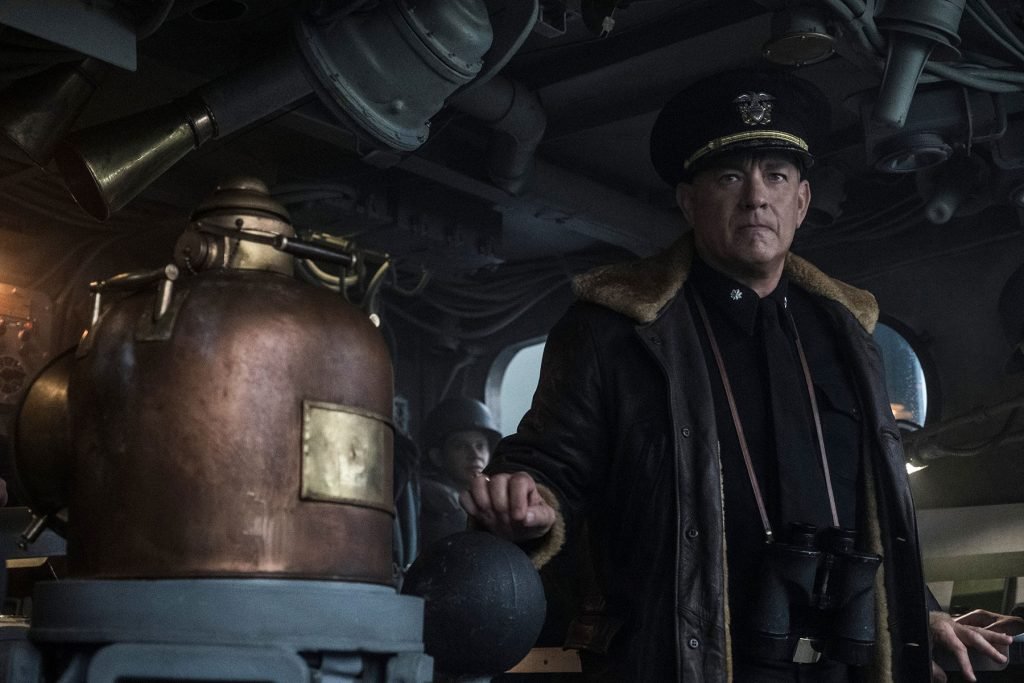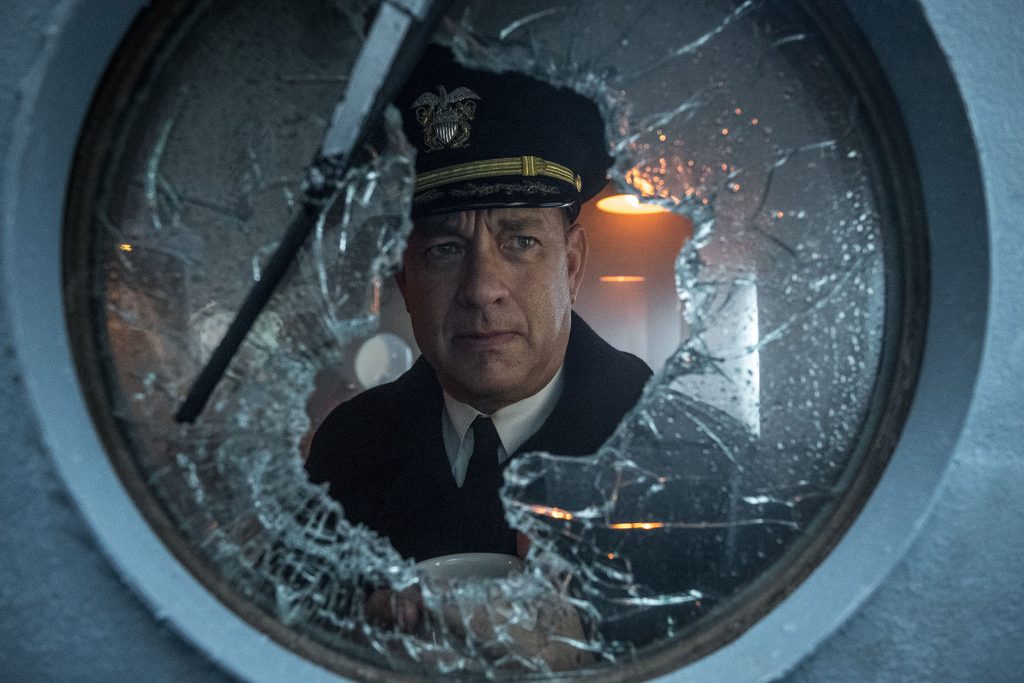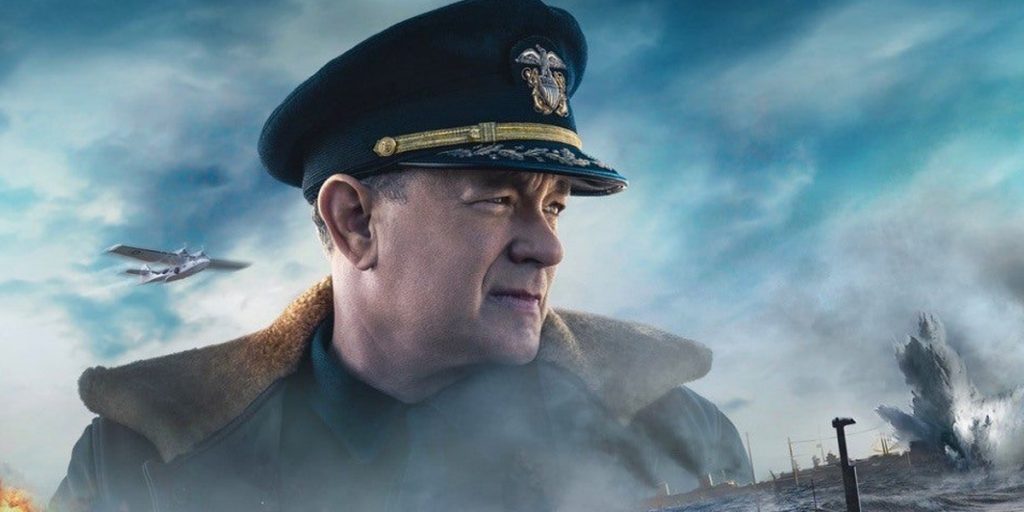An Interview with the talented crew responsible for Greyhound, Tom Hanks’ and Aaron Schneider’s World War II submarine film.
I had the opportunity to sit down virtually with a number of the team responsible for Apple TV+’s submarine warfare drama, Greyhound. I was struck by the film’s detail-oriented craftsmanship so, needless to say, I was excited to speak with so many of the artisans responsible for crafting such a technically proficient film.
Joining the conversation were:
- Cinematographer Shelly Johnson (Captain America: The First Avenger)
- Costume designer and two-time Academy Award nominee Julie Weiss (Twelve Monkeys)
- Production designer and Emmy winner David Crank (The Master, Knives Out)
- Composer and three-time Emmy nominee Blake Neely (The Pacific, the Arrowverse shows)
- Editors Mark Czyzewski (Mad Men) and Academy Award nominee Sidney Wolinsky (The Shape of Water)
- Visual effects supervisors Academy Award nominee Nathan McGuinness (Master and Commander: The Far Side of the World) & Academy Award winner Pete Bebb (Inception, The Dark Knight Trilogy)
- Sound designer and 12-time Academy Award nominee (and three-time winner) Michael Minkler (Black Hawk Down, Chicago, Once Upon a Time in … Hollywood)
As Mark Czyzewski explained, the film’s production was a “pain staking, but very rewarding process.” “The goal was to put the audience right on deck next to the captain” (Johnson). Mike Minkler described that throughout the process “authenticity was very important.” One thing that came across most clearly was that the crew was very proud of the work they had done on this film. “It was a company. We all did work together, all of us!” exclaimed Julie Weiss.

Director Aaron Schneider’s Role in the Film’s Success
The crew credits director Aaron Schneider’s detail-oriented approach for much of the film’s success. “The focus in this movie is the details.” (Czyzewski). Production designer David Crank explained Schneider’s process: “Aaron had figured out beforehand where all the boats were at every moment, which isn’t always explained in the film because it isn’t necessary, but it was important for us to know where every location was as we made the actual film.” In describing the challenge of depicting a highly technical battle scene in a way understandable to audiences, editor Sidney Wolinsky exclaimed that the director “knew exactly what he was shooting and why, and how to help us make that intelligible to the audience.”
The Experience of Collaborating with Tom Hanks
Tom Hanks’ is not only the star of the film, but also the screenwriter and a boots on the ground production leader. Editor Mark Czyzewski showed a lot of appreciation for Hanks’ efforts on the film: “he keeps the room light and makes for a great creative environment.” He explained further that “Tom has a great deal of respect for the audience and always gives them credit that they’ll get it. He’s focused on the meat of the story.”
Greyhound’s Focus on the Details
Perhaps the film’s greatest technical challenge facing the crew was figuring out how to convey the massive amount of technical information in Hanks’ script to the audience in a way that could be digested easily both visually and aurally. This is not the sort of screenplay that slots in a rookie seaman to serve as the audience proxy. One of the editors, Sidney Wolinsky, described: “one of the challenges for me was figuring out what was going on. Our director is very smart and understood all the minutiae of everything in terms of space.” He continued “[the director] could tell me how many shells needed to be shot in reality to kill a sub. There’s different sonar – a slow sonar and a fast sonar – one is for the closer the submarine [gets] you switch from slow to fast because it’s coming so quickly. That’s what the story was about, the very specific challenges of a destroyer finding a submarine and successfully destroying it. The challenge was understanding it and trying to realize that.” The sort of precise information was necessary to construct the elements of the film cohesively. His editing partner, Mark Czyzewski, explained further “[it was] gratifying to see the audience had a thirst for all the information we packed into it.”
Finding Costuming Creativity within the Constraints of the World War II Genre
Costume designer Julie Weiss delighted in describing the challenges of outfitting the soldiers: “the clothes come from everywhere. If I could draw and design things, I have sketches. You would draw everything if you had time, you would make everything. But it doesn’t stop you from setting a goal, you draw and create as if you have everything in the world, and then you go towards that.” She described her overriding goal as making sure that “a military movie does not diminish the individual” and thus saw it as critical to subtly differentiate the men. For example, one sailor received a hat one size too large so that it would always sit slightly askew on his head. “Tom Hanks of course we made his uniform. He stood with such grace. This was who [the character] has been, the commission he has been waiting for, so his uniforms were made [by hand].” Weiss explained further “during the war there were not enough uniforms, some were left over from World War I. Some men drew on the backs of their jackets. The Levis company began to make the jackets, women’s skirts became shorter to save fabric.” These are the sort of details Weiss infused in her designs.

The Pursuit of Historical Accuracy
The makers of a film as focused on specific details as Greyhound must, you can imagine, spend a lot of time focused on historical accuracy. The crew was able to visit the USS Kidd in Louisiana and to use that ship as a model for the film. The film’s cinematographer recalls “when we saw the actual destroyer, it was very tight. The interiors even a little tighter than what we built so that Tom [Hanks] could walk around in front of the portals.” As the production designer explained, much of the film’s challenges could be addressed by relying on a surviving example of a destroyer “We were extremely [fortunate] to have the ship there as a living encyclopedia. You can find a lot of picture of the outside of ships, but not a lot of the insides. They didn’t want anyone to know what the insides looked like [during the War]. So having the USS Kidd, but also having a lot of people who worked in that ship and in their group. The messman who ran the ship would call his mentors and their network to learn answers to our questions. It was interesting because it was more hands-on learning.”
In addition to the USS Kidd, the crew relied on a database for reference materials. Visual effects supervisor Pete Bebb, a passionate student of history himself, explained “they built a huge database for us of good old images of North Atlantic ships that would be around the convoy.“ The crew used the database to generate explosions and damage similar to what real World War II destroyers would have experienced. This helped focus the team on an accurate depiction of naval warfare. “What you have to understand is the crew is not making up sequences here it’s very authentic to things that actually happened, and I think that’s key to making the film feel real.” His visual effects partner, Nigel McGuinness, elaborated: “We went to the level of listening to journalists on the merchant ships while attacks were occurring and they’re recording their internal dialogue. Just amazing accounts and descriptions from that moment in time… They helped us try to understand the situation from a filmmaking and character [perspective].” Bebb concluded by expressing his hope that viewers would be inspired to “go and look up the Battle of the North Atlantic and see what was actually undertaken by the crewmen, and just what was achieved.”
Bringing the War to Life Through Special Effects
One of the greatest challenges facing the crew was filming a movie about naval warfare without ever setting foot on the water. The special effects faced a unique challenge here as none of the water seen in the film is real – almost the entire movie was made on soundstages. Nigel McGuinness explained: “It was really a kind of a daunting project because we didn’t have the ability to shoot out in the ocean. We were more going by the script, by what Tom felt the environment, the awful feeling of being in this situation, not only the situation but also the environment itself. That was all generated in CG. Pretty much anything you see outside is all CG.”
The cinematographer faced similar challenges: “film being a two-dimensional medium, we cheat angles and we cheat distances a lot to make things work on a two dimensional screen. [There was no cheating here.] At one point during prep, [director Aaron Schneider] came to me and asked if the tanker is two miles away, how do we make it look like an event even if we’re not going to cheat it closer. How can we make that look like more than just a blip on the horizon? [I told him that] at night we could be fighting through the spray and the thick air and the explosion can light the entire atmosphere through the thick air.” It ended up as one of the film’s most visually striking shots.
The effects crew seems inspired by the work they have done here and how it can inform their work in the future. Nigel McGuinness was asked to describe what he learned from the project: “movies made around the ocean are always a run for the hills situation. Water! Water! I feel like we took [that issue] to another place. I think we’re fascinated in where we can go [with water based films]. As senior guys in the effects field, I feel like that we’ve opened up the world of quality and can almost create true believability now. You’d want to do another Master and Commander now. I feel like you could almost relax a studio by saying it’s not just the technology, it’s the right people, right team and right mentality.” McGuinness explained further that the evolution of CGI has helped his job to change over the years. “I think the technology is so far ahead now that we have time to be artists. We have time to talk and have a dialogue like filmmakers like cinematographers and like a camera crew. We’ve got time to execute that way because technology is better and faster.” Deservedly, the effects have been rewarded with significant award season buzz and positive notes from critics.
Sound Design… and Oscar Glory?
Perhaps the film’s strongest chance for Academy Award victory the Spring is in the sound category. Sound designer Mike Minkler described his philosophy on the film: “You can find original sounds on reels in libraries. The question is how far you take it from there – we’re making a movie so you don’t want it to be strictly authentic, you want it to be dramatic and exciting. You sweeten things with new elements, and that goes to taste. You experiment with different sizes and shapes of the guns to make sure they all sound unique and powerful and beautiful. It’s an emotional thing that’s meant to incite and amaze you.” He also described a fruitful collaboration with composer Blake Neely: “because of the modular construction of the music, we were able to move things around when best needed. There are lots of different parts of the orchestra the way Blake delivers it which lets us refer to different pieces of the music where we can use them best.” Neely explained further that “there’s so much lingo you don’t understand so you’re needing to stay out of the way of that [with the score so the audience can learn the lingo].”
Composer Blake Neely described his score noting that “whale sounds were the inspiration. I see this movie as part thriller, part period piece, and part horror movie. Is it a synth, is it a whale, is it a violin being played very poorly through a bunch of effects? It is!” he joked. “It’s a human playing this weird sound that gets under your skin.”
Greyhound’s Release on Streaming, instead of Theaters
Greyhound was originally intended for theatrical release, before COVID-19 changed the plans and the film was sold to Apple TV+. The crew seemed largely happy with the film’s release on the young streaming service. To be clear, nobody was willing to give up on the value of the theatrical experience. As the crew explained, “the scale and impact on the big screen is amazing” (McGuinness) and “you see so many details from Julie’s costumes to David’s sets. The film becomes a lot more faceted on the big screen.” (Johnson). Nevertheless, as cinematographer Shelly Johnson explained “if I knew this was happening ahead of time, would I have done anything? I don’t think I would have, I would have shot it like this.” Mike Minkler made clear that while initially he had some concerns about the transition to a streaming service impacting his work, Apple worked hard to allay his fears “I spoke with the Apple engineers who made a special streaming version of the sound mix. They gave me a test run, then I conferred again with them when the release came.” Composer Blake Neely described that “under normal circumstances, it would be gone from theaters. Apple has done a tremendous job so it’s pretty cool that when you turn on your Apple TV it’s still there like a first run business. Nobody approached it like some sort of streaming lesser than so everything was left on the screen to see how epic it was.”
Greyhound is now available to watch on AppleTV+.

